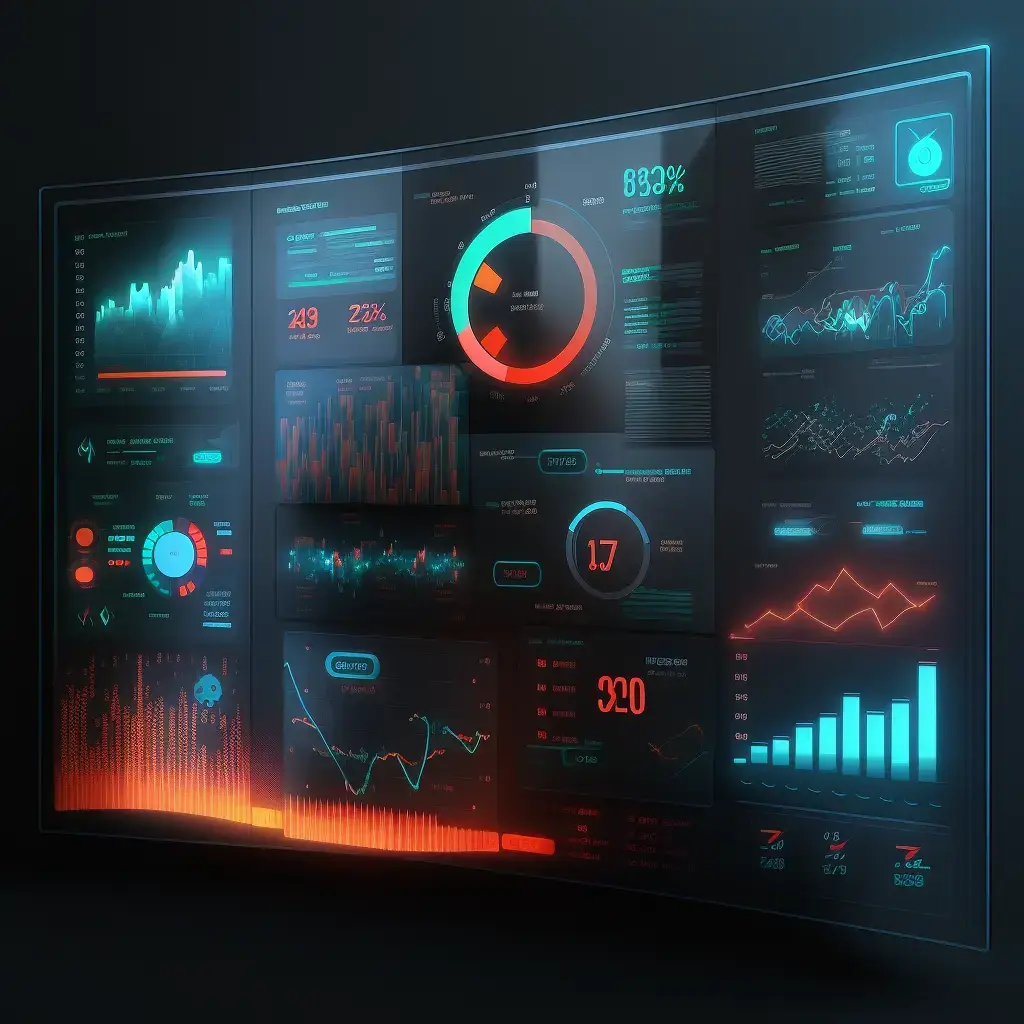
Unleashing the Power of Business Analytics
 Abe Dearmer
Abe Dearmer

Apr 20, 2023
∙
10 min read

Analytics
Discover the transformative power of business analytics in this comprehensive guide. Learn about different types of analytics, their applications, and the tools and technologies shaping the future of data-driven decision-making.
Key Takeaways:
- Business analytics comprises descriptive, diagnostic, predictive, and prescriptive analytics, each with its unique purpose and applications.
- Harnessing various analytics techniques enables businesses to optimize operations, forecast market trends, and capitalize on opportunities.
- Popular tools and technologies for business analytics include proprietary software solutions, open-source alternatives, and emerging AI and machine learning technologies.
- Fostering a data-driven culture is crucial for organizations to fully leverage the power of business analytics, driving success and competitiveness.
- Future trends in business analytics encompass AI and machine learning integration, ethical considerations, and the increasing importance of data visualization.
Table of Contents
- Introduction to Business Analytics
- Descriptive Analytics: Understanding Your Business
- Diagnostic Analytics: Unravel the Reasons
- Predictive Analytics: Gaze into the Future
- Prescriptive Analytics: Take Action with Confidence
- Key Tools and Technologies for Business Analytics
- Building a Data-Driven Culture: Tips for Success
- FiveCRM: Business Analytics in Action
- Future Trends in Business Analytics
- Conclusion: Embrace Business Analytics for Success
- Frequently Asked Questions
Introduction to Business Analytics
In today's competitive business landscape, data-driven decision making has become indispensable. Business analytics empowers organizations to turn vast amounts of data into actionable insights and drive informed decision-making. By leveraging various types of business analytics, such as descriptive, diagnostic, predictive, and prescriptive analytics, businesses can optimize their operations, predict market trends, and capitalize on new opportunities.
Descriptive Analytics: Understanding Your Business
Descriptive analytics is the foundation of business analytics. It entails analyzing historical data to summarize and understand the past performance of a business. By identifying patterns and trends, businesses can grasp the essential factors that have influenced their performance.
Common techniques used in descriptive analytics include data aggregation, data visualization, and statistical analysis. These methods help condense raw data into easily digestible information, facilitating better decision-making.
For instance, a CRM software company might use descriptive analytics to assess customer churn rate or sales performance. By understanding past trends, the company can develop strategies to improve customer retention and boost sales.
Diagnostic Analytics: Unravel the Reasons
Diagnostic analytics dives deeper into the data, seeking to uncover the causes behind observed patterns or trends. By answering the question "why did it happen?", diagnostic analytics helps businesses identify the factors that contribute to their success or failure.
Techniques such as correlation analysis, data mining, and root cause analysis are commonly employed in diagnostic analytics. These approaches help businesses pinpoint the variables responsible for specific outcomes.
A sales management team, for example, might use diagnostic analytics to determine why a particular sales campaign was successful. By identifying the contributing factors, they can replicate their success in future campaigns and avoid pitfalls.
Predictive Analytics: Gaze into the Future

Predictive analytics harnesses the power of data and machine learning algorithms to forecast future outcomes based on historical data. This type of analytics enables businesses to anticipate market trends, customer behavior, and other critical factors that may impact their operations.
Common techniques used in predictive analytics include regression analysis, time series analysis, and neural networks. These methods help organizations make data-driven predictions about future events.
A CRM software provider might use predictive analytics to anticipate customer needs or identify potential sales opportunities. By understanding what is likely to happen in the future, the company can allocate resources effectively and capitalize on emerging trends.
Prescriptive Analytics: Take Action with Confidence
Prescriptive analytics takes predictive analytics a step further by recommending the best course of action for a given situation. By leveraging optimization and simulation algorithms, prescriptive analytics guides businesses in making informed decisions and maximizing their chances of success.
Scenario planning, decision trees, and linear programming are examples of techniques used in prescriptive analytics. These methods help organizations identify the optimal solutions to complex problems.
For instance, a sales management team might use prescriptive analytics to determine the most effective sales strategy, taking into account various factors such as market conditions, competition, and customer preferences. By implementing data-driven recommendations, the team can increase the likelihood of achieving their goals.
Key Tools and Technologies for Business Analytics
Business analytics relies on various tools and technologies to analyze data and generate actionable insights. Popular software solutions include Tableau, Microsoft Power BI, and Salesforce Einstein Analytics. These platforms offer comprehensive analytics capabilities, allowing businesses to derive insights from their data with ease.
In addition to proprietary solutions, open-source alternatives like R and Python are widely used for business analytics. These programming languages offer a flexible and cost-effective approach to data analysis, enabling businesses to customize their analytics workflows.
Emerging technologies, such as artificial intelligence and machine learning, are also playing a pivotal role in shaping the future of business analytics. By automating complex analytical tasks, these technologies enable businesses to unlock deeper insights and make more informed decisions.
Building a Data-Driven Culture: Tips for Success
To fully leverage the power of business analytics, organizations must cultivate a data-driven culture. This involves fostering data literacy, encouraging a data-driven mindset, and ensuring data quality and privacy.
-
Encouraging data literacy: Empower employees to understand and use data effectively by providing training and educational resources. Data literacy is essential for employees at all levels to make informed decisions and contribute to the organization's success.
-
Cultivating a data-driven mindset: Promote a culture that values data-driven decision-making by encouraging employees to question assumptions, validate hypotheses with data, and continuously learn from data-driven insights.
-
Ensuring data quality and privacy: Maintain robust data governance practices to ensure data accuracy, completeness, and security. By safeguarding data quality and privacy, organizations can build trust and make more confident decisions based on their analytics.
FiveCRM: Business Analytics in Action
FiveCRM has built-in analytics and reporting that are flexible and customizable to your needs, yielding success stories and valuable lessons.
-
Show your value: Provide updates to your clients on calling campaign performance through in-depth reports demonstrating meetings booked, calls made, and overall campaign results.
-
Monitor Performance: Monitor sales rep performance by building an understanding of login time, activities completed, call responses, and the number of emails sent.
-
Automate Reports: Spend less time generating manual reports; with FiveCRMs custom report writer, you can build out the query once and have automatic reports distributed to the relevant people on a frequency of your choice.
- Fully customizable: All of our reports are fully customizable and are able to display a number of different formats and data sets, enabling you to modify reports to meet your client's needs.
These case studies demonstrate the immense potential of business analytics in driving organizational success and shaping industry best practices.
Future Trends in Business Analytics

As technology continues to evolve, new trends are shaping the future of business analytics:
-
Artificial intelligence and machine learning: The integration of AI and machine learning into business analytics tools will further automate analytical tasks and uncover deeper insights, enabling organizations to stay ahead of the competition.
-
Ethics and bias in analytics: As analytics become more prevalent, ethical considerations and bias mitigation will become increasingly critical to ensure fair and transparent decision-making processes.
-
The role of data visualization: As the volume and complexity of data continue to grow, effective data visualization will play a crucial role in communicating insights and driving data-driven decisions.
Conclusion: Embrace Business Analytics for Success
Business analytics is a powerful tool for driving informed decision-making, optimizing operations, and unlocking growth potential. By embracing the various types of analytics and leveraging cutting-edge tools and technologies, organizations can stay ahead in the competitive landscape.
Now is the time to embark on your journey towards data-driven success. Unleash the power of business analytics and unlock your organization's full potential today!
Frequently Asked Questions
What is the importance of business analytics in decision making?
Business analytics is crucial in decision making as it helps organizations transform vast amounts of data into actionable insights. By utilizing different types of analytics, such as descriptive, diagnostic, predictive, and prescriptive, businesses can optimize their operations, forecast market trends, and capitalize on new opportunities. In essence, business analytics empowers organizations to make data-driven decisions that enhance performance, efficiency, and competitiveness.
How do descriptive, diagnostic, predictive, and prescriptive analytics differ?
-
Descriptive analytics summarizes historical data, providing insights into past performance and helping businesses understand patterns and trends that have influenced their operations.
-
Diagnostic analytics delves deeper into the data, seeking to uncover the reasons behind observed patterns or trends, and answering the question "why did it happen?".
-
Predictive analytics uses historical data and machine learning algorithms to forecast future outcomes, enabling businesses to anticipate market trends, customer behavior, and other critical factors that may impact their operations.
-
Prescriptive analytics recommends the best course of action for a given situation by leveraging optimization and simulation algorithms, guiding businesses in making informed decisions and maximizing their chances of success.
Popular tools and technologies for business analytics include:
- Proprietary software solutions such as Tableau, Microsoft Power BI, and Salesforce Einstein Analytics, which offer comprehensive analytics capabilities for businesses.
- Open-source alternatives like R and Python, which provide flexibility and cost-effectiveness for customizing analytics workflows.
- Emerging technologies like artificial intelligence and machine learning, which automate complex analytical tasks and enable businesses to unlock deeper insights.
How can companies foster a data-driven culture?
To foster a data-driven culture, companies should:
- Encourage data literacy by providing training and educational resources, empowering employees to understand and use data effectively.
- Cultivate a data-driven mindset by promoting a culture that values data-driven decision-making and encourages employees to question assumptions, validate hypotheses with data, and continuously learn from data-driven insights.
- Ensure data quality and privacy by maintaining robust data governance practices, safeguarding data accuracy, completeness, and security.
What are some key trends shaping the future of business analytics?
Key trends shaping the future of business analytics include:
- The integration of artificial intelligence and machine learning into business analytics tools, further automating analytical tasks and uncovering deeper insights.
- The growing importance of ethics and bias mitigation in analytics to ensure fair and transparent decision-making processes.
- The increasing role of data visualization in communicating insights and driving data-driven decisions, as the volume and complexity of data continue to grow.
Michael King says...
"I can’t think of a time where a client has requested something that we weren’t able to do with FiveCRM. Unlike most systems, it has a lot of flexibility."

Managing Director, Senior Response
JAINE HUSBANDS SAYS...
“Each client, and each of their campaigns, has its own unique specifications. We essentially needed to set up mini CRMs on one platform to meet those requirements.”

Operations Director, Team Marketing
Why wait?
Start improving your outbound efficiency now, with the most customizable Sales solution on the market.